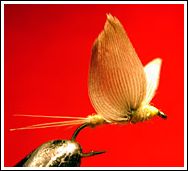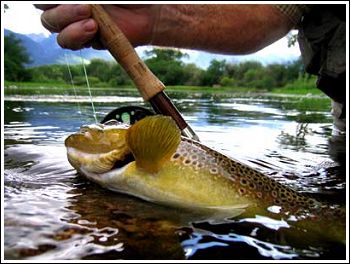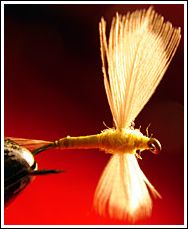|
PMD Hatch
"The Pale Morning Dun Hatch
produces fun, challanging fishing!"
By George Anderson

Here in Livingston, and across Montana
we are blessed with a phenomenal hatch of a large, olive cast mayflies
that everyone calls Pale Morning Duns. For trout hunters, the PMD hatch
makes for some spectacular dry fly fishing. Various PMD hatches occur
during the period from late June throughout July and often well into
August on many of our streams.
This is THE hatch of the year on the
famous spring creeks of Paradise Valley, like Armstrong’s, DePuy’s and
Nelson’s. Anglers in the know book early to secure a space on these
spring creeks during "prime time" of the PMD hatch, knowing that this
will be some of the finest fishing – especially dry fly fishing – of the
entire year.
This hatch occurs on most Montana
streams, usually in July, but different species of the same basic insect
make this perhaps the most important hatch of the season, especially on
the flat-water streams like the spring creeks, the Firehole, Slough
Creek, Soda Butte and the Lamar river in Yellowstone Park and also
tailwaters like the Lower Madison and the Missouri.

The first PMD’s of the season to appear
are the largest – the Ephemerella Infrequens, which are imitated with
duns that average size 16 but often look as large as 14’s. Rene’
Harrop’s PMD No-Hackle in a size 16 with a big gray wing silhouette and
pale olive body is a perfect imitation.

Harrop PMD No Hackle
Here on our spring creeks, we’ll see
good hatches of Infrequens starting in mid-June. Early to mid-July
produces some of the best dry fly fishing on these larger PMD’s. The
Infrequens hatches seem to taper off at the end of July, but at the same
time, another smaller version of the PMD appears, know as the
Ephemerella Inermis and these hatches continue throughout July and well
into August. The Inermis looks like a scaled down version of its larger
brother, just one to two sizes smaller. A PMD imitation in size 18 is
generally the best size but 20’s will often work even better on the
well-educated trout of the spring creeks. Although you will periodically
see some of the larger PMD’s throughout the summer, the majority of
hatches in mid July throughout August will be the smaller Ephemerella
Inermis.
Typically the PMD hatches start at 9-10
AM on most days and are heaviest for a period of 2-4 hours, bringing up
lots of big fish. You’ll find big fish slurping them in everywhere, and
it looks like it is going to be a piece of cake catching a ton of fish,
but it is often not quite that easy! The challenge and the “game” that
we all play is finding that exact fly that will fool these fish without
hesitation.

Much of the time it looks to the
un-initiated that the trout are taking high riding duns, but during the
PMD hatches, I’ve found that fishing emergers, cripples and even
emerging nymphs is usually the ticket to catching a lot of fish. The
trout seem to recognize that the high riding duns can fly off the water
at any given moment, so they pass them up, looking for duns that are
struggling in the surface film, trying to free themselves from their
nymphal shuck. When this is happening, two-tone emergers like the Dr.
Barr PMD emerger, and Rene Harrop’s PMD CDC Captive Duns are deadly. The
back half is brown, like the nymph, while the front half of these flies
are a brighter pale olive or yellow/olive of the emerging mayfly.

Fish seem to realize that these
struggling duns are easy prey, and they search them out relentlessly,
often passing up 90% of the high riding duns. Good anglers score well
with both nymphs like a Sawyer Pheasant Tail in size 16-18, or any of
the good emerging PMD nymphs like our Olive Drake, a fly with a darker
wing case that imitates the nymph splitting out of its shuck on the way
to the surface.
As well as emergers, cripples and
drowned duns in the surface film are easy prey during the PMD hatch. One
of my most effective patterns, that I’ll go to when it seems nothing
else will work is Rene Harrop’s simple short wing, Olive emerger. I
grease this up and fish it right in the surface film, but you can also
fish it sub-surface like an emerging nymph. Various cripple patterns can
be deadly, like the Last Chance Cripple in 16’s and 18’s. I often fish
an Olive spinner during the height of the hatch, as trout are looking
for any duns that have not been able to upright themselves and are
drifting helplessly in the surface film.
Sight fishing to nymphing fish in the
spring creeks is extremely effective and a lot of fun since you can
target the largest fish, and they are often not any tougher to get to
take the fly than the smaller fish. The crystal clear water of the
spring creeks allows an angler to observe feeding fish more closely, and
the fun part of the game begins, changing patterns and trying to find
that one fly that will consistently have big trout moving three to four
feet to suck it in! Then the fun starts, while these strong 16-20 inch
rainbows and browns cartwheel across the pool sometimes running hard and
long enough to get you into your backing.
 A bonus during the PMD hatches is
getting to fish the spinner falls in the evenings. On most days when the
hatch is heavy, look for these PMD spinner falls from 6-8 PM in the
evenings, especially if it is relatively calm. All those duns you see in
the grass in mid-day will be dancing in their mating flights and then
falling spent on the water in the evening, making them the easiest of
targets for big fish. A good spinner fall will bring up a lot of big
fish, giving the dry fly enthusiast another couple of hours action that
can be fast and furious. A bonus during the PMD hatches is
getting to fish the spinner falls in the evenings. On most days when the
hatch is heavy, look for these PMD spinner falls from 6-8 PM in the
evenings, especially if it is relatively calm. All those duns you see in
the grass in mid-day will be dancing in their mating flights and then
falling spent on the water in the evening, making them the easiest of
targets for big fish. A good spinner fall will bring up a lot of big
fish, giving the dry fly enthusiast another couple of hours action that
can be fast and furious.
This is the excitement of the PMD
hatch, one that brings back anglers year after year to fish the Spring
Creeks and other streams where the PMD’s abound.

Here in Livingston, during July and
August, it is easy and fun to combine a day or more on the spring creeks
with some float fishing on the Yellowstone River or perhaps the Madison,
where the fishing is easy, and you can throw big attractor drys, hoppers
and even streamers.
We (www.yellowstoneangler.com)
book guided trips with many of the finest guides in our area that
specialize in fishing these PMD hatches on the Spring Creeks. There is
no better way to learn to catch fish under the challenging conditions
like these PMD hatches provide than to hire one of these top guides for
a day or more. You can often learn more in one day than you might on
your own in five years!
Casting accuracy and timing the rise
rhythm of an individual trout and anticipating where the trout will rise
next is often the key to success, and this is where a good guide can
really help. Once you learn to catch fish consistently during the height
of the PMD hatch, you’ll be able to catch fish anywhere under difficult
conditions.
Article written by George Anderson ©
www.yellowstoneangler.com
|